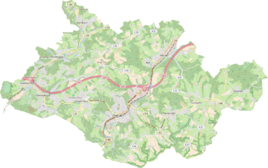Wustsiefen
|
Wustsiefen
City of Overath
Coordinates: 50 ° 57 ′ 20 ″ N , 7 ° 16 ′ 57 ″ E
|
||
|---|---|---|
| Height : | 192 m above sea level NN | |
|
Location of Wustsiefen in Overath |
||
Wustsiefen was a district of Overath in the Rheinisch-Bergisches Kreis in North Rhine-Westphalia , Germany . The place fell desolate at the end of the 20th century .
location
The district of Wustsiefen can only be identified in older maps and lists. It was to be found above today's Kreisstraße 38, around 500 meters west of Kleinbalken . Some sources of the Lehmichbach have their source nearby .
history
The court overath had existed since 1633. His jurisdiction extended beyond the goods belonging to the parish Overath. Wustsiefen was also affiliated with the Overather Höfeverband with its courtyards (localities) Obersteeg , Oberbech , Lokenbach , Wüsterhöhe and the Balker Höhe .
The Topographia Ducatus Montani by Erich Philipp Ploennies , Blatt Amt Steinbach , proves that the living space had a courtyard as early as 1715, which is labeled as Wustsiefen and designated as Freihof . Carl Friedrich von Wiebeking names the court on his charter of the Duchy of Berg in 1789 as Wüstsiefen . From it it emerges that the place was part of the Honschaft Balken in the parish of Overath at that time .
The place is recorded on the topographical survey of the Rhineland from 1817 as Wüstsiefen . The Prussian first recording from 1845 shows the residential area under the name Wustsiefen . From the Prussian new admission from 1892 to the 1971 edition, the place is recorded on the measurement table as Wüstsiefen .
In 1822 six people lived in the place categorized as a courtyard and designated as Wustseifen , which after the collapse of the Napoleonic administration and its replacement belonged to the Overath mayor in the Mülheim am Rhein district . For the year 1830 40 inhabitants are given for the place called Wustseifen . In 1845, according to the overview of the government district of Cöln, categorized as a farm and designated as Wustsiefen , had four residential buildings with 21 inhabitants at that time, all of which were Catholic.
The list of inhabitants and cattle from 1848, which among other things was used to collect taxes, has eighteen inhabitants in Wustsiefen, including six children. She gives the names and occupations of the heads of household. Three of them were farmers : Anton Büscher (and tenants, 1 ox, 2 cows, 2 pigs) , Wilhelm Fischer (1 ox, 2 cows, 1 cattle, 1 goat, 1 pig) and Michael Funk ( 1 ox, 3 cows, 2 pigs ). As without Gewerb were Gerhard Buescher ( 3 goats ) and Christchurch. Brochhagen ( poor, no assets ) listed and the single shoemaker Johann Dahl as deaf and dumb .
The municipality and estate district statistics of the Rhine Province list Wustsiefen 1871 with three houses and 24 inhabitants. In the municipality lexicon for the Rhineland province of 1888, five houses with 22 inhabitants are given for Wustsiefen . In 1895 the place had five houses with 22 inhabitants,
In the address book of Heiligenhaus from 1901 the following are recorded for Wustsiefen: Johann R. Bromberg, Wilhelm Meeger and Wilhelm Rott, all Ackerer, whereby Meeger is also described as a tenant.
In 1905 three houses and 16 inhabitants are given.
The place was demolished in the 1970s.
Individual evidence
- ^ Hanspeter Dresbach: Municipal reorganization 165 years ago , in: Rheinisch-Bergischer Calendar 1975, p. 20
- ^ Wilhelm Fabricius : Explanations for the Historical Atlas of the Rhine Province ; Second volume: The map of 1789. Division and development of the territories from 1600 to 1794 ; Bonn; 1898
- ↑ Alexander A. Mützell: New topographical-statistical-geographical dictionary of the Prussian state . tape 5 . Karl August Künnel, Halle 1823.
- ↑ Friedrich von Restorff : Topographical-statistical description of the Royal Prussian Rhine Province , Nicolai, Berlin and Stettin 1830
- ↑ Overview of the components and list of all the localities and individually named properties of the government district of Cologne: by districts, mayor's offices and parishes, with information on the number of people and the residential buildings, as well as the Confessions, Jurisdictions, Military and former state conditions. / ed. from the Royal Government of Cologne [Cologne], [1845]
- ↑ Berthold Gladbach, Peter Lückerath: The Overather population in name, tax and residents lists from the 15th to the 20th century . Ed. Geschichtsverein Rhein-Berg, Bergisch Gladbach 2016. ISBN 978-3-932326-75-2 , p. 344.
- ↑ Royal Statistical Bureau Prussia (ed.): The communities and manor districts of the Prussian state and their population . The Rhine Province, No. XI . Berlin 1874.
- ↑ Königliches Statistisches Bureau (Prussia) (Ed.): Community encyclopedia for the Rhineland Province, based on the materials of the census of December 1, 1885 and other official sources, (Community encyclopedia for the Kingdom of Prussia, Volume XII), Berlin 1888.
- ↑ Königliches Statistisches Bureau (Prussia) (Ed.): Community encyclopedia for the Rhineland Province, based on the materials of the census of December 1, 1895 and other official sources, (Community encyclopedia for the Kingdom of Prussia, Volume XII), Berlin 1897.
- ↑ Royal Statistical Bureau (Prussia) (Ed.): Community encyclopedia for the Rhineland Province, based on the materials of the census of December 1, 1905 and other official sources, (Community encyclopedia for the Kingdom of Prussia, Volume XII), Berlin 1909

